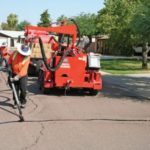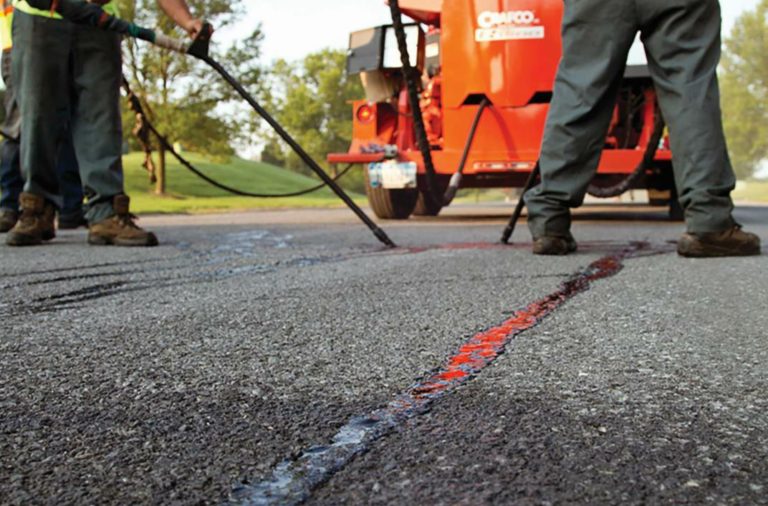Crack sealing is the first line of defense against pavement failure, and it is also a cost-effective maintenance step that contributes to the overall health and life of your pavement.
Crack filling keeps moisture from getting into the pavement, which would otherwise cause  damage to the foundation and the breakdown of the binder in asphaltic concrete. Keeping water damage to a minimum will prevent weeds from getting a foothold. Plant growth can raise the pavement, compromise its structural integrity, and result in failures and potholes.
damage to the foundation and the breakdown of the binder in asphaltic concrete. Keeping water damage to a minimum will prevent weeds from getting a foothold. Plant growth can raise the pavement, compromise its structural integrity, and result in failures and potholes.
Crack sealing is the most cost-effective pavement preservation solution that provides the most benefit. However, just because something is cost-effective does not mean it should be left to chance.
Here are some tips to make the most of your efforts:
Ensure all cracks are clean and dry.
Start with clean, dry cracks to achieve the best adhesion and longevity.
Water is the number one adversary of pavement and cracks sealant applications. If it has rained lately — or is now raining — postpones work until another day.
If the pavement is dry enough, thoroughly clean cracks to remove any dirt or debris that might interfere with your work. You can use a wire brush or compressed air duster to clean the area. You will also want to use a heat gun to ensure that the pavement is at the proper application temperature — which is 40°F or higher.
When applying sealant, you may notice excessive bubbling, which indicates the presence of moisture and debris. Stop immediately and re-clean the cracks before applying any more sealant.
Routing may be necessary.
Routing cracks before Crack Sealing them can improve the odds of effective sealant adherence by 40% while also doubling the service life of the sealant!
 Routing creates fresh, uniform edges that help the sealant adhere more effectively and a reservoir that allows for thermal movement.
Routing creates fresh, uniform edges that help the sealant adhere more effectively and a reservoir that allows for thermal movement.
However, not every project should be routed — a crack density greater than 20%, crocodile cracking (or fatigue cracking), or other signs of severe distress on the pavement indicate that it may not be strong enough to sustain routing.
Use the correct sealant.
The properties of sealants vary depending on the climate, viscosity, and other factors. When choosing your sealant, be sure that it meets all applicable specifications and that the sealant lot is readily available in case of an issue.
First and foremost, consider the type of heating. Direct- and indirect-fired sealants are not interchangeable. You must choose them based on the type of melter/applicator you have.
Additionally, if you swap sealants in between jobs, remember to thoroughly empty the tank before applying a different sealant — as combining two sealants can radically alter the chemistry of the sealant you are using.
 Finally, heat the sealant according to the manufacturer’s guidelines and agitate it thoroughly. Overheated or overworked sealant can degrade, shortening the pot life and causing adhesion problems. An underheated sealant will also not flow down to the depth of the crack.
Finally, heat the sealant according to the manufacturer’s guidelines and agitate it thoroughly. Overheated or overworked sealant can degrade, shortening the pot life and causing adhesion problems. An underheated sealant will also not flow down to the depth of the crack.
You should also avoid dumping in too many blocks at once since this can lower the temperature of the heated sealant in your tank and cause delays. To maintain correct flow and application temperature, add fresh sealant in the same quantity as you are laying it down on the surface. In some melters/applicators, a buildup of blocks can cause the agitation paddles to get clogged.
Follow all safety precautions.
Crack sealing can be performed on the busiest highway or the quietest parking lot. Be careful to use appropriate personal protective equipment (PPE), safety cones, and other tools wherever it is performed to reduce any potential hazards.
The safest crack sealing project is the best crack sealing project!
For Crack Sealing contact us, Contact detail is below.
Address
Commonwealth Paving, 136 Outerloop, Louisville, Kentucky 40214
Phone: 502-459-7283, Fax: 502-456-2678
Opening Hours
| Monday | 9:00 AM – 5:00 PM |
| Tuesday | 9:00 AM – 5:00 PM |
| Wednesday | 9:00 AM – 5:00 PM |
| Thursday | 9:00 AM – 5:00 PM |
| Friday | 9:00 AM – 5:00 PM |
| Saturday | Closed |
| Sunday | Closed |







